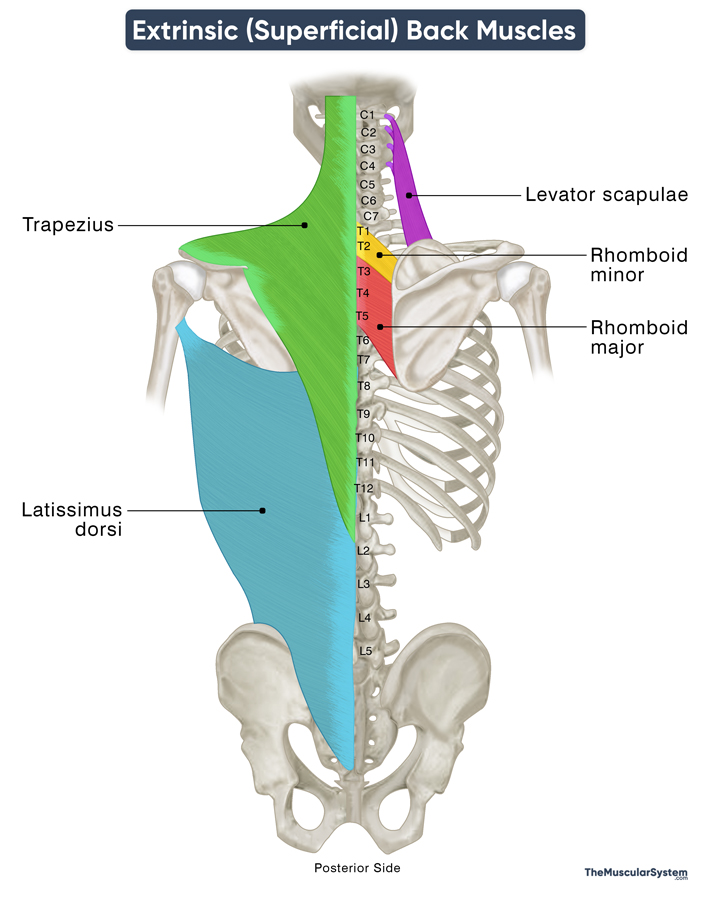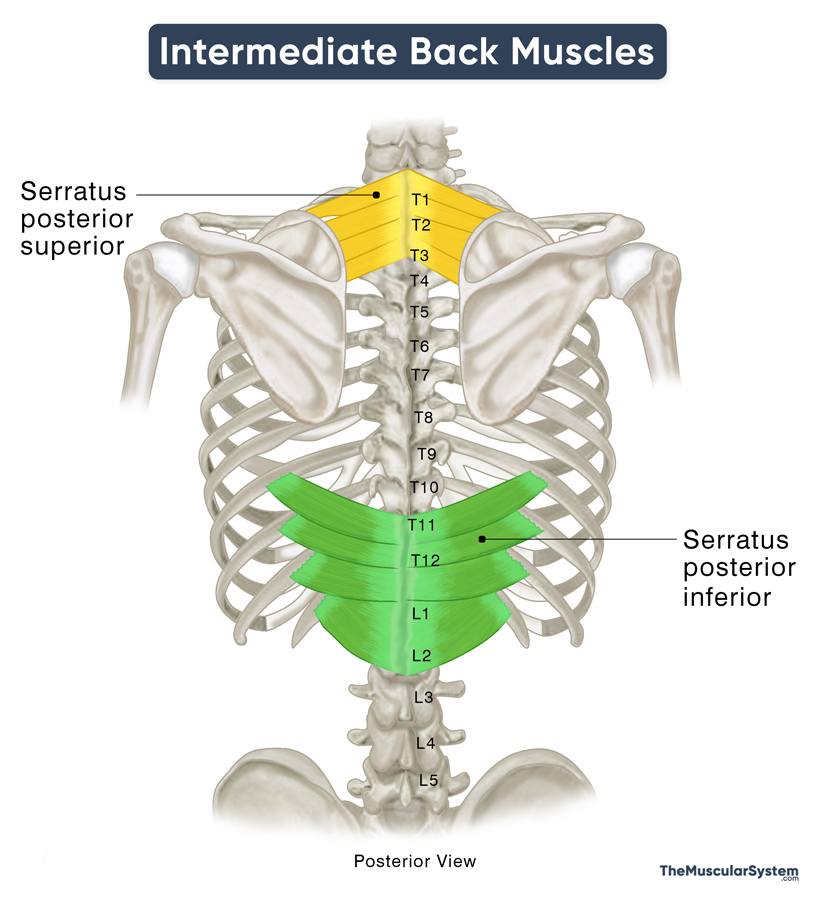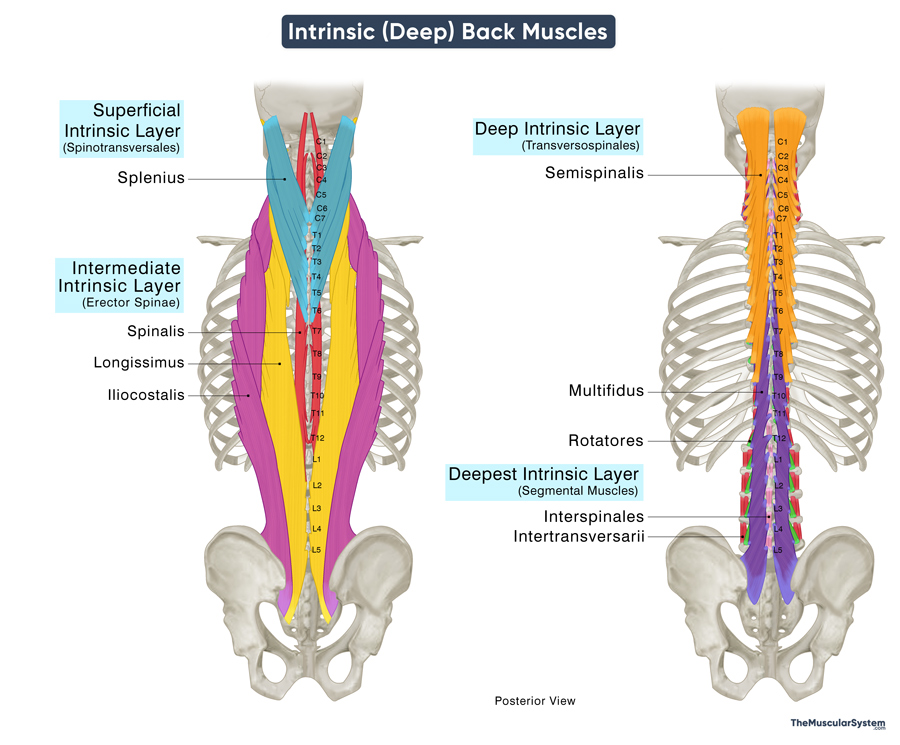Back Muscles
The human back comprises many small and large muscles that provide structural support and flexibility, allowing for various movements of the spinal column and the whole torso. This group includes some of the major muscles essential for moving the body. All muscles located from the base of the skull, across the shoulders, and down to the top of the hips are considered back muscles.
Name, Location, and Anatomy of the Muscles of the Back
All the muscles in the back are paired, with most of them comprising groups of multiple smaller muscular slips or fascicles that contribute to the stability, flexibility, and intricate movements of the spinal column to bring about the movements of the head, neck, and body trunk.
While it is difficult to count the exact number, the human back muscles can be divided into 3 groups or layers based on their location and functions in the region — (1) superficial or extrinsic, (2) intermediate, and (3) deep or intrinsic.
Find out about all the muscle groups within these three layers:
| Name | Location | Origin | Insertion | Action | Innervation |
|---|---|---|---|---|---|
1. Superficial or Extrinsic Muscles (5)Have attachments on the shoulder and arm bones, which is why they are often considered to be upper limb muscles. |
|||||
| Trapezius | Upper back and neck, spanning from the base of the skull to the middle back and out to the shoulders | The medial third of the superior nuchal line and external occipital protuberance of the occipital bone, the nuchal ligament, and the spinous processes of the C7 to T12 vertebrae | Back of the clavicle’s lateral one-third and the acromion and spine of the scapula or shoulder blades | Elevating, retracting, and rotating the scapula while also assisting in extending the neck and bending it to the sides (when the scapula remains fixed) | Ventral rami of C3-C4 spinal nerves and the accessory nerve |
| Latissimus dorsi | Lower back and side, stretching from the lower spine up to the armpits | The inferior angle of the scapula, the spinous processes of T7-T12 vertebrae, the 9th to 12th ribs, and the posterior surface of the iliac crest | The bicipital groove of the humerus bone | Internally rotating, extending, and adducting the arms and helping with the movement of the ribs during respiration | Thoracodorsal nerves arising from C6-C8 spinal nerves |
| Rhomboids (2) | |||||
| — Rhomboid major | In the upper back, between the scapulae or shoulder blades | The spinous processes of T2-T5 vertebrae | The medial border of the scapula | Retracting the scapula and rotating it downwards at its joint with the thorax | Dorsal scapular nerves rising from the C4-C5 spinal nerves |
| — Rhomboid minor | Just above the rhomboid major, between the shoulder blades | The spinous processes of C7 and T1 vertebrae, and the nuchal ligament | Same as rhomboid major | Same as rhomboid major | Same as rhomboid major |
| Levator scapulae | Along the side of the neck, connecting to the upper part of the shoulder blades | The Transverse processes of C1-C4 vertebrae | The medial border of the scapula, on the superior surface | Elevating the scapula and assisting in tilting the neck | Dorsal scapular nerve of C5 and C3-C4 cervical nerves |
2. Intermediate Muscles (2)Have attachments on the ribs and help in moving the thoracic cage. They are usually included in the chest muscle group. |
|||||
| Serratus posterior (2) | |||||
| — Serratus posterior inferior | Lower back, just above the lumbar region, beneath the latissimus dorsi | The spinous processes of T11-L2 vertebrae | Lower borders of 9th-12th ribs | Depressing the lower 3-4 ribs when breathing out | T9-T11 intercostal and the subcostal nerves |
| — Serratus posterior superior | Upper back, deep to the shoulder blades, closer to the spine | The nuchal ligament and spinous processes of the C7-T3 vertebrae | Upper borders of 2nd-5th ribs | Elevating the upper ribs when breathing in | T2-T5 Intercostal nerves |
3. Deep or intrinsic Muscles (12)Have attachments on the spinal column and play a vital role in moving the back and torso. Some sources consider this to be the only group of true back muscles. All these muscles originate from points inferior to where they are inserted. |
|||||
| Superficial Intrinsic Layer or Spinotransversales (2) | |||||
| Splenius (2) | |||||
| — Splenius capitis | Back of the neck, extending up to the base of the skull | Spinous processes of C7-T3 vertebra and the nuchal ligament | The occipital bone and temporal bone (mastoid process) | Straightening, rotating, and laterally flexing the head and neck | Dorsal rami of C2-C3 spinal nerves |
| — Splenius cervicis | Upper back and neck, below the splenius capitis, running down into the cervical vertebrae | Spinous processes of T3-T6 vertebrae | Transverse processes of C1-C3 vertebrae | Same as splenius capitis | Dorsal rami of the lower cervical nerves (C3 and lower) |
| Intermediate Intrinsic Layer or the Erector Spinae Group (3) | |||||
| Spinalis | Thin, long muscle along the spine, running from the middle back up through the midline to the base of the skull | Spinous processes of C7-T1 and T11-L2 vertebrae, and the nuchal ligament | Spinous processes of C2-C4 and T1-T8 | Bending the upper back and trunk to the sides and extending the back, neck, and trunk | Dorsal rami of corresponding spinal nerves |
| Longissimus | Runs along the sides of the spine from the lower back to the neck. | Transverse processes of C4-T5 and L1-L5 vertebrae and the ilium and sacrum bones | Transverse processes of cervical, thoracic, and lumbar vertebrae, and the mastoid process of temporal bone | Bending the head and trunk to the sides, straightening the back and neck, and bending them backward | Same as Spinalis |
| Iliocostalis | Outermost back muscle along the ribs, from the hips and lower back to the upper back. | Angles of the 3rd-12th ribs and lateral sacral and iliac crests | Transverse processes of C4-C7 and L1-L4 vertebrae and the angles of all the ribs | Straightening the beck and back, and bending sideways | Same as Spinalis |
| Deep Intrinsic Layer or Transversospinales (5) | |||||
| Semispinalis (3) | |||||
| — Semispinalis Capitis | Upper back and neck, just beneath the skull and alongside the spine | Articular processes of C4-C7, and transverse processes of C7-T6 vertebrae | On the occipital bone, between the superior and inferior nuchal lines | Straightening, bending, and rotating the head and neck | Dorsal rami of C1-C5 spinal nerves |
| — Semispinalis Cervicis | Neck and upper back, running between the vertebrae of the cervical spine. | Transverse processes of T1-T6 vertebrae | Spinous processes of C2-C5 vertebrae | Same as the semispinalis capitis | Dorsal rami of the lower cervical nerves (usually C3-C6) |
| — Semispinalis Thoracis | Middle and upper back, along the spine | Transverse processes of T6-T10 vertebrae | Spinous processes of C6-T4 vertebrae | Straightening and rotating the head and trunk, as well as bending them sideways and arching backward | Dorsal rami of corresponding cervical and thoracic nerves |
| Multifidus | Runs along the entire length of the spine, from the lower back to the neck | Superior articular processes of C4-C7, transverse processes of all thoracic vertebrae, mammillary processes of all lumbar vertebrae, and the back of sacrum and ilium bones | Spinous processes of vertebrae located 2 to 5 segments above the point of origin of each fascicle | Stabilizing the spine and assisting other muscles in extending, bending, and rotating it | Dorsal rami of corresponding spinal nerves |
| Rotatores | Along the spine from the neck to the lower back, but most prominent in the thoracic region | Transverse processes of all vertebrae (most prominent in the thoracic region) | Spinous process and laminae of vertebrae located 1-2 segments above the origin of each fascicle | Stabilizing the spinal column and helping with straightening and rotating the thoracic spine region | Dorsal rami of corresponding spinal nerves, mainly the thoracic nerves |
| Deepest Intrinsic Layer or Segmental Muscles (2*) | |||||
| Interspinales | Tiny muscles located between the vertebrae, running along the entire spine, but most developed in the cervical and lumbar regions | Spinous processes of C3-L5 vertebrae | Spinous processes of C2-L4 vertebrae | Stabilizing the spinal column | Dorsal rami of corresponding spinal nerves |
| Intertransversarii | Along the spine, on the side of the vertebrae; most prominent in the cervical and lumbar regions | Transverse processes of cervical and lumbar vertebrae and accessory processes of lumbar vertebrae | Transverse and mammillary processes (in the cervical region) of the vertebrae inferior to the point of origin | Same as interspinales | Ventral and dorsal rami of corresponding spinal nerves |
*Note that the levatores costarum, originating from the transverse processes of C7-T11 and inserted into all 12 ribs, is sometimes considered to belong to the deepest intrinsic layer. However, it is more appropriate to classify them as thoracic wall muscles based on their primary role in elevating the ribs during respiration.
The deep and deepest intrinsic muscles play a role in proprioception, which means helping the body sense its position and movement, allowing for adjustments and stability during various activities. They contribute significantly to the coordination of movements between the arms and legs in relation to the trunk.
FAQ
What is the largest muscle in the back?
The largest and strongest muscle in the back is the latissimus dorsi, or “lats.” This broad, flat muscle extends from the lower back, wraps around the sides of the torso, and attaches to the humerus in the upper arm. It plays a key role in actions such as rotating and extending the arm and pulling it back, helping with climbing, and lifting heavy objects with your arms. It also works as an accessory muscle of respiration.
References
-
- Back Muscles: ClevelandClinic.org
-
- Muscles of the Back: TeachMeAnatomy.info
-
- Anatomy, Back, Muscles: NCBI.NLM.NIH.gov
-
- Overview of the Back Muscles: Kenhub.com
-
- Back Muscles: What to Know: WebMD.com








